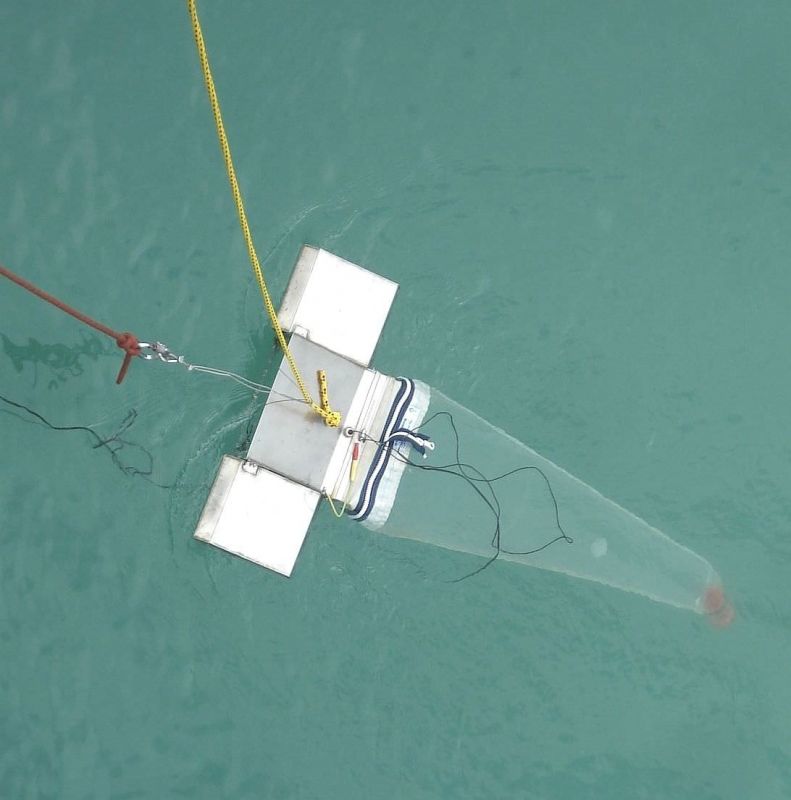Microplastics in Rivers: Rhein and Danube
Published on by Water Network Research, Official research team of The Water Network in Academic
To what extent are Germany's rivers contaminated by microplastics? A study published recently provides some specific clues for the first time.
Between 2014 and 2017, a research group at the University of Bayreuth led by Prof. Dr. Christian Laforsch gathered and analysed water samples from 22 rivers, mainly in the catchment area of the Rhein and Donau (Danube) rivers. The new findings now represent one of the world's largest data sets from standardized studies on the appearance of plastic particles in rivers.
The study was commissioned by the German states of Baden-Württemberg, Bavaria, Hesse, North Rhine-Westphalia, and Rhineland-Palatinate.

When taking samples, the "Mini Manta" trawl, developed in Bayreuth, is pulled through the water by a boat or hangs from a bridge, as shown in the picture. Photo: Isabella Schrank. Source: UoB
The 52 water samples under examination were taken from regions in southern and western Germany that varied greatly with respect to landscape, settlement, and industrial density. The researchers in Bayreuth found and analysed more than 19,000 objects in these samples of which 4,335 were unambiguously identified as plastic particles.
Around 99 percent of these plastic particles are smaller than 5 millimetres and are thus classified as microplastics. Tiny particles with a diameter of 0.02 - 0.3 millimetres (20 - 300 micrometers) are the most common: they account for 62 percent of the plastic particles that were found. What is striking is that higher concentrations of microplastics tend to be found in small and medium-sized tributaries. Only low to medium concentration levels were measured in the Rhein, the largest body of water studied.
Polyethylene and polypropylene are the types of plastic that have the highest market share in Europe. Unsurprisingly, the majority of particles analysed were also made of these types of plastics. The irregular, fragmentary appearance of most particles suggest that they are fragments of larger plastic objects. In addition, plastic fibres were discovered at many sampling sites. Other forms of particles such as foil remnants, beads, or pellets were not discovered as often.
Taking samples of water near the surface of rivers poses a difficult technical challenge. For this reason, the research group in Bayreuth developed a special "Mini Manta" trawl for their investigations. A built-in flow metre measures the amount of water sampled, allowing the concentrations of microplastics to be precisely determined. The particles that were discovered were then precisely measured and chemically analysed in a laboratory. In this context, special equipment for micro-FTIR spectroscopy was used. "The advantage of this method is that even the tiniest particles that are only 0.02 millimeters can be unambiguously identified as plastics on the basis of their infrared spectra," explained Dr. Martin Löder, an environmental engineer at the University of Bayreuth.
The findings of the new study showed a level similar to findings from comparable bodies of water elsewhere in Europe and in North America. Prof. Dr. Christian Laforsch emphasized that in many respects further research on the spread of microplastics in inland waters is still needed. "This study has given us some detailed initial insights into microplastic contamination of Germany’s rivers. However, precisely understanding the origin, temporary accumulation, and final destination of microplastics in bodies of water will require a great deal of future research," said Prof. Laforsch.
Publication:
The Study Mikroplastik in Binnengewässern Süd- und Westdeutschlands is available online:
www.lanuv.nrw.de/landesamt/veroeffentlichungen/publikationen/sonderreihen-und-ausgaben
Source: University of Bayreuth
Media
Taxonomy
- Water Pollution
- Contaminant Removal
- River Studies
- Pollution
- Contaminant Movement Mapping
- River Restoration
- Plastic Parts
- Plastics
- Pollution
- Plastic Pollution